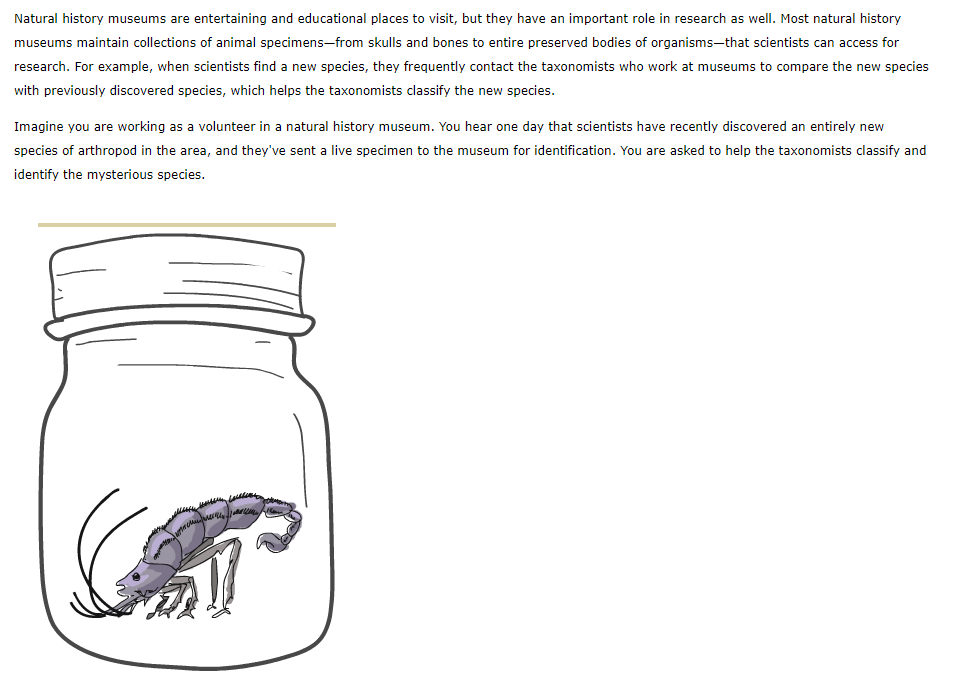Natural history museums are entertaining and educational places to visit, but they have an important role in research as well. Most natural history museums maintain collections of animal specimens-from skulls and bones to entire preserved bodies of organisms-that scientists can access for research. For example, when scientists find a new species, they frequently contact the taxonomists who work at museums to compare the new species with previously discovered species, which helps the taxonomists classify the new species. Imagine you are working as a volunteer in a natural history museum. You hear one day that scientists have recently discovered an entirely new species of arthropod in the area, and they've sent a live specimen to the museum for identification. You are asked to help the taxonomists classify and identify the mysterious species.
Natural history museums are entertaining and educational places to visit, but they have an important role in research as well. Most natural history museums maintain collections of animal specimens-from skulls and bones to entire preserved bodies of organisms-that scientists can access for research. For example, when scientists find a new species, they frequently contact the taxonomists who work at museums to compare the new species with previously discovered species, which helps the taxonomists classify the new species. Imagine you are working as a volunteer in a natural history museum. You hear one day that scientists have recently discovered an entirely new species of arthropod in the area, and they've sent a live specimen to the museum for identification. You are asked to help the taxonomists classify and identify the mysterious species.
Concepts of Biology
1st Edition
ISBN:9781938168116
Author:Samantha Fowler, Rebecca Roush, James Wise
Publisher:Samantha Fowler, Rebecca Roush, James Wise
Chapter11: Evolution And Its Processes
Section: Chapter Questions
Problem 4RQ: What is the difference between micro- and macroevolution? a. Microevolution describes the evolution...
Related questions
Question
100%
please see I selected the correct choices for 1-3
in case I have not I will list their options
1 options:
-jointed appendages
-soft fleshy appendages
-no appendages
2 options:
-two pairs of antennae
-no antennae
-one pair of antennae
3 options:
-wings
-no wings
4 options:
-crustacean
-chelicerate
-insect

Transcribed Image Text:Natural history museums are entertaining and educational places to visit, but they have an important role in research as well. Most natural history
museums maintain collections of animal specimens-from skulls and bones to entire preserved bodies of organisms-that scientists can access for
research. For example, when scientists find a new species, they frequently contact the taxonomists who work at museums to compare the new species
with previously discovered species, which helps the taxonomists classify the new species.
Imagine you are working as a volunteer in a natural history museum. You hear one day that scientists have recently discovered an entirely new
species of arthropod in the area, and they've sent a live specimen to the museum for identification. You are asked to help the taxonomists classify and
identify the mysterious species.

Expert Solution
This question has been solved!
Explore an expertly crafted, step-by-step solution for a thorough understanding of key concepts.
This is a popular solution!
Trending now
This is a popular solution!
Step by step
Solved in 2 steps

Knowledge Booster
Learn more about
Need a deep-dive on the concept behind this application? Look no further. Learn more about this topic, biology and related others by exploring similar questions and additional content below.Recommended textbooks for you

Concepts of Biology
Biology
ISBN:
9781938168116
Author:
Samantha Fowler, Rebecca Roush, James Wise
Publisher:
OpenStax College

Concepts of Biology
Biology
ISBN:
9781938168116
Author:
Samantha Fowler, Rebecca Roush, James Wise
Publisher:
OpenStax College